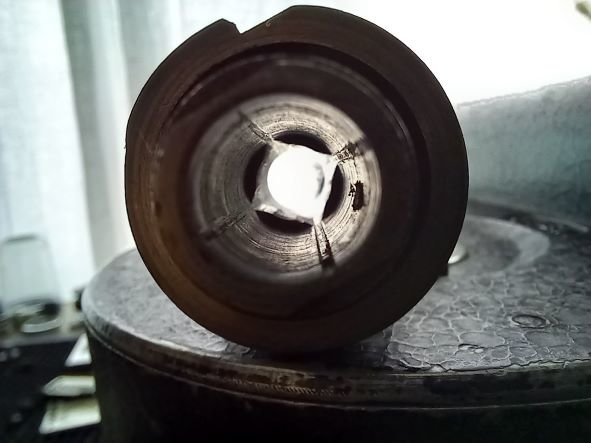-
Posts
2,587 -
Joined
-
Last visited
Everything posted by Simon Wyss
-

Slates: Black and White vs. Color
Simon Wyss replied to Nolan M Berbano's topic in Camera Assistant / DIT & Gear
A synch slate serves sound work first. Why worry about colours as long as that point has not become crystal clear? The slate should be nicely visible in the frame of the intended aspect ratio, steady, sharp, legible, open before the announcement, closed not like lightning yet with a nice slap for the sound record, held in place for a second, and then swiftly and entirely removed from the scene. Haven't we discussed the slate? Colours on the slate only make sense when the grader knows with certainty that its illumination can cope with the illumination of the scene. My opinion -
Funny. Steven Spielberg and no one around to understand there are polyester base stocks that can be welded. Very durable joints.
-

Testing Motion Picture Stocks with an SLR
Simon Wyss replied to Ari Davidson's topic in Film Stocks & Processing
Nuuhh, Hal, I'd say the reason is technical. They don't like to stitch or tape so many short lengths together and the stitches tear the squeegees down. Damaged squeegees are something most unwanted with processing machines. -
Jade? You state Director of Photography in your profile and ask such questions? Something must be rotten in the state of Denmark.
-
Check out this: http://www.schutzcarbon.com/arc_carbon.html
-
Found something exciting: Code 1414, Kodak High Definition Aerial Film 3414 on an Estar ultra-thin base of 1.5 mil = 0,0381 mm, ~ 1970. Reference: http://www.taphilo.com/photo/kodakfilmnumxref.shtml (wrong metrical value given there) That would lead to 400 ft of film on the H spool in your Eyemo.
-
Do you know the ‘A’ type core? Its diameter is one inch, you can place it on the spindle with its square bore. So you find some of them and roll her. Better of course were spools with smallest possible core. Next point: Get thinner film. If they've been on the moon there was Eastman-Kodak Ektachrome 160 (T ?) on a thinner polyester base. Maybe that somewhere there's still an odd film made by the yellow brother, maybe even in 35 and perforated. I don't know. What I know for certain is that there are black-and-white stocks with a dry thickness of 2.7 mils.
-
Dear Paul, no. But, films are becoming made thinner like in the case of Gigabitfilm 40 in the 16 mm gauge (0.068 mm or 2.7 mils). More (black an white) stocks are likely to be availabe on a thinner base in the future. Which means, you'll load 200 feet on the hundred-foot spool. Only problem is to get thin film processed. I'm working on that, a new machine design.
-
An idiot must have had your camera in his hands. For luck, the tachometer can easily be inverted in its holding once the body is open. I think they should correct that for free if you point it out soberly. All the best
-
The trick is to thump a cartridge two or three times onto its feed side to loosen the windings a little prior to inserting. Feed side is the one with the sticker on.
-
You haven't peeped through an Arriflex II C yet.
-

Accidentally shot some old PlusX 50ASA
Simon Wyss replied to Anthony Schilling's topic in Film Stocks & Processing
Correct, you have the two ways. Light is cheaper, much better environmentally, and as even as a chemical treatment. The chemical way is common with the color reversal processes. -
More information about alloy No. 12: It's been called American Alloy Number Twelve. Easier to work than pure aluminum and smaller degree of shrinkage. Copper addition by a pre-alloy of Al and Cu fifty-fifty. For those of you who cannot resist to restore a Bell & Howell Standard
-
Hello, Karl and everyone What I meant was the color reversal internegative film of Fuji for printing out on it but in the 16 mm format there are the specially designed films like EASTMAN EXR Color Intermediate Film 2244™ / 5244™/ 7244™. Aaand, there are the microfilms, correct, only not in 16. The reason why I cooled off a little cinematography-wise is that I have begun my apprenticeship as a mechanic. They call it polymechanic now in this country but the profession is still with saw, file, drill, lathe, milling and grinding machine. My occupation until summer 2010.
-
Better not print stock but intermediate film such as EASTMAN Color Internegative II Film 5272/7272. In the black and white realm you have a lot of low speed stocks: Gigabitfilm 40 and the younger Gigabitfilm HDR 32 (35 mm only), internegative films, interpositive films with a little more contrast. In 35 mm you have additionally photo films in case you employ a simple camera, I mean with a simple claw mechanism: Fuji color printout film, and others
-

Script writing
Simon Wyss replied to Chris Anderson's topic in Students, New Filmmakers, Film Schools and Programs
Find this not too bad. Can continue like Voice: I am thirsty. CU of dog MC of Mike and Jason, bewildered Voice of dog: C'me on, fellows, let's find a bar! Group strolls away. -
The Bell & Howell Eyemo camera was introduced in 1925. Announcement in the May issue of the SMPE Journal Never mind
-
Wow, Karl, what's bitten you in the meantime? I can't see any purist attitude with somebody who has film in her or his hands, and the question was so beautifully simple. Does film cement work with modern stock tells me so much about Aaron. There is a director who wants to know about the very base of our industry. I have just reread US Patent 610,861 of September 13, 1898, to Hannibal Goodwin of Newark, NJ: What I claim as new is an improvement in the art of making transparent flexible, photographic-film pellicles, the same consisting in dissolving nitro-cellulose in a . . . There is not a trace of arrogance in Aaron's post. We who know well enough can explain to him that PET polyester is chemically inert, i. e. not affected by any substance in view of making a bond between two pieces of such film. So we enter film manufacturing history over triacetate base to nitrate base and the ugly beginning with the betrayal of Goodwin by Eastman (US Patent 417,202 of December 10, 1889, to Henry M. Reichenbach). I read Witnesses: George Eastman, Fred F. Church. We're back in 1887 when Goodwin filed the application on May 2. Since then nothing has changed. Film cement is in close touch with the fabrication of film. The rest, in my ears, is silence, perhaps the humming noise of my ultrasonic polyester film welder.
-

A small improvement for the Film WASHING process
Simon Wyss replied to Terry Mester's topic in Film Stocks & Processing
Thank you for the idea -
Were the distributors less silly had we 16-mm polyester prints in the cinemas. The exhibitors in their turn break a fly on the wheel by using 35-mm equipment opposite twelve foot high screens. That's the realm of small gauge. Let there be reduction printing !
-
My H 16 S with magazine housing: Kern-Switar 25-1.4, brass, coated Kern-Switar 50-1.4, alum, coated Benoist-Berthiot 10-1.9, alum, coated (iris free from backlash) Kern-Stereo-Yvar 12.5-2.8 Also three H 8 Reflex, Kern lenses from 5.5 to 150 mm, 8—36 hand iris and EE
-
Yes, we can: Magazine Bolex have anodized aluminium plates.
-

tips for becomming a better assistant?
Simon Wyss replied to ian henderson's topic in Camera Assistant / DIT & Gear
Why not strut over to the Ford Museum and start browsing the movies catalog. Ask politely, try to come in contact with the IMAX theatre manager, who knows if you won't find a treasure in some can. Talks are so important! -
Noah, better don't sink the ship. The forum never sucks, only some members do. Your subject, as it appears to me, might perhaps, under circumstances and maybe not be of absolute prime interest to most of the users here. Stating you are a camera operator you should be able to read a light meter and transport the value to the iris ring. Also you should be in the position to measure distances between camera (film plane) and object. The disk scale on the camera back is no more than an aid in finding correct iris values for a given film speed and frame rate. What is truly unknown at the moment is the opening angle in the rotary shutter. I should start with the presumption of 170 degrees. One day you'll know exactly. The photographic layer of motion-picture film consists of gelatine (and more). Taking the film's end between your lips you will notice that one side is rather sticky — that is the photographic side which must face the aperture plate and lens. It all starts with patience . . .
-
U. S. Patent 2,284,757 to Alton W. Morton, Salt Lake City, June 2, 1942; filed October 18, 1939: Parallax-free view finder with auxiliary lens turret Mounted on Bell & Howell Filmo Sportster, ball lock at center


